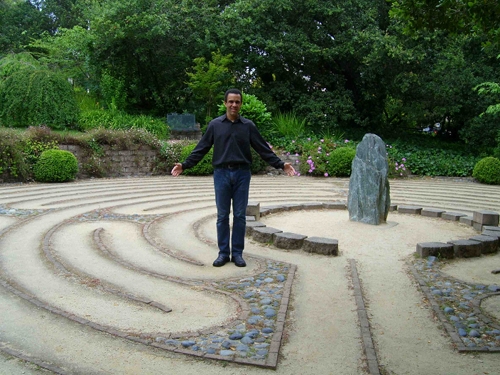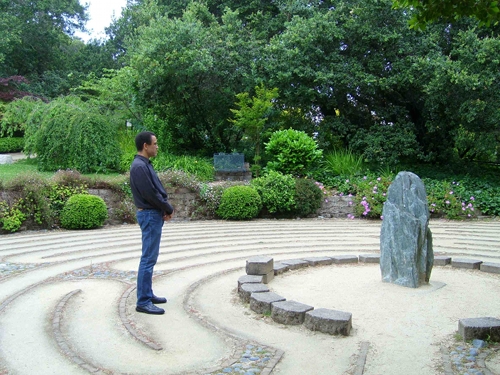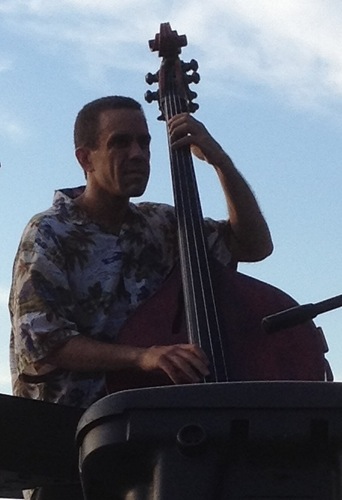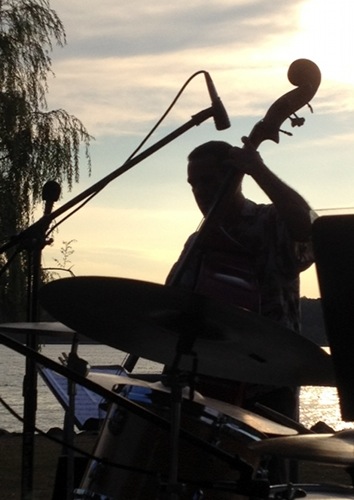

SR: What is your musical background?
PB: I grew up in the San Francisco Bay area which is a very culturally diverse area. It's extremely musically diverse as well. Different cultures are celebrated so anyone who grows up there is exposed to quite a bit. California used to be a part of Mexico so there's a strong Latino influence everywhere. San Francisco also has strong Asian influences, being one of the only major U.S. cities that has a Chinatown, Japantown, and Koreatown. When I grew up it also had a healthy jazz scene, blues scene, plenty of gospel music, latin jazz, pop, rock, punk, speed metal, classical music, marching bands, the whole spectrum.
As I began to develop my musical tastes I was more attracted to the music of the 60s and 70s, particularly anything blues and groove influenced: Jimi Hendrix, Muddy Waters, Motown, Stevie Wonder, Santana, James Brown and later Tower of Power, Herbie Hancock's Headhunters band, Weather Report, Jaco Pastorius. On the other side, the rock super groups like Rush, Yes, King Crimson, Genesis and early Peter Gabriel were a big influence. I had every Led Zeppelin record at one point. I like that period of musical exploration where all the genres were being mixed together and boundaries were being broken.
This influenced the direction I started to take when I began playing music. Piano was my first instrument at age 4 and like many other neighborhood kids, we just learned a standard method like Yamaha or something just to have some musical training. I did that for a few years and dropped it because I got bored with reading music all the time. At 8, I played drums and trumpet for a year or two then dropped those for the same reason. At 12, my junior high school band needed drummers and since I had done that before, I took it up again. The band director was actually also a dixieland drummer. He began to teach me himself. Once I started learning that you could improvise and play music that wasn't on the page, it was all over.
From that point forward I became a serious drummer and played all through junior high school and high school. That's when I also started learning the music I was listening to. I was a performing jazz and rock drummer by the time I graduated from high school. I took first place in a drum competition when I was 18. Around that time I was hearing bass more and more and had already started playing electric bass. I also went through a period of being a percussionist and I studied Cuban, Brazilian and African percussion. In the end, for me bass won out. Electric bass became my primary instrument for a few years and as I played more jazz on electric bass, it became apparent that upright acoustic bass would be the natural move if I wanted to get more into Ray Brown, Rufus Reid and Paul Chambers. At 22, I finally got the courage to start acoustic bass and I've been playing both basses ever since but primarily acoustic.
I found that my background in drums and percussion have been very important in the way that I play bass, in the way that I hear music and in the projects I've chosen to be a part of. I still play piano now to write and arrange my music and my early trumpet playing gave me a sense of melody and phrasing with the breath that I still draw from when I write and improvise. Many people have said my music is very lyrical and I think that comes from that early exposure to playing trumpet.
Deciding to do the Americas project has everything to do with my reverence for percussion and the various rhythms of Latin America. You could spend your entire life listening to the folk music of just one country in Latin America and still get a wide variety. It's pretty amazing when you think about it.
SR: Who are your musical influences and what do you like listening to?
PB: My musical influences are extremely varied because of my wide musical background. Stevie Wonder and Donny Hathaway are still two of my favorite musical artists of all time - great singing, great songwriting, soul and groove. In terms of jazz bass playing, Ray Brown, Sam Jones, Paul Chambers, Buster Williams, Rufus Reid, Christian McBride and my teacher John Clayton are my strongest influences. In terms of leading a band, Duke Ellington, Dizzy Gillespie, Herbie Hancock, Miles Davis, Cannonball Adderley and Tony Williams are among my favorite bandleaders. People sleep on Tony Williams as a bandleader. I'm particularly a fan of the recordings he did with his quintet late in his career.
Composition has always intrigued me so I developed a love for classical music that still goes. I'll never forget getting a discount CD when I was 17 - it was Beethoven's 4th Symphony. I thought I was being hip by having a classical CD. I didn't know what was going to happen after that. I lost my mind. I couldn't figure out what he was doing. I couldn't sleep for a week. I bought the score right away and started trying to figure it out. I had no formal training in analyzing classical music but I didn't care. I tried anyway. The only other artist that had that kind of influence on me was Miles. I knew I needed to study jazz and classical for the rest of my life. I'm a Ralph Vaughan Williams nut. I was introduced to his music a few years later. His Symphony No. 7 "Sinfonia Antartica" is one of the things that addicted me to classical. When I attended Berklee College of Music, I was a (classical) Composition and Film Scoring double major. I was already performing jazz every night so I knew that would be my last chance to get a thorough understanding of classical music. I still hold a huge classical collection but I don't perform classical as much. I'm an avid listener. I guess that Beethoven CD started it and Ralph Vaughan Williams solidified it. I still study classical scores along with the recording whenever I get a down moment.
Currently, aside from my slow burn love of classical, I like whatever grooves. If there's a heavy pocket, I'm in and I want to know more about it. My love for the groove is what led me early on to be attracted to R&B, funk, Motown and later, swing and various Latin and Caribbean styles. I guess my ear is always leading me to the drums and rhythm first. I continue to be a student of Haitian music, which I've been doing for 10 years now. The Americas project helps me continue to explore the various rhythms of the Caribbean, South and Central America. Every country has it's own flavor and identity. It's amazing.
Pathways was in India last year and I began listening to a ton of Indian music after we got back. I'm blown away by what they've been able to accomplish rhythmically, let alone the ragas and other aspects of the music. It's very possible that the next Pathways CD will be a tribute to South and Central Asian music. Either way you can rest assured we will be doing original arrangements and finding our way around these incredible musical journeys.

SR: How did the Rhythm Road tour come about?
PB: The U.S. State Department auditions bands from all over the U.S. every year. The competition is fierce; about 7% of the applicants make it in. The program started as the Jazz Ambassadors in 1960 founded by Adam Clayton Powell as a way to build goodwill between the US and other countries. Louis Armstrong, Duke Ellington, Dizzy Gillespie and Dave Brubeck are among the pioneers. Rhythm Road is Jazz At Lincoln Center's vision of the program.
I did my first Rhythm Road tour as a bassist with Alvin Atkinson and the Sound Merchants. We did a Middle East tour in 2007 to United Arab Emirates, Yemen, Oman, Saudi Arabia, Jordan, Israel and the Palestinian territories. Alvin taught me a lot about how to be a cultural ambassador and teacher. Pathways was chosen in 2010 to do a Latin American tour to Trinidad and Tobago, Suriname, Nicaragua and Honduras and again in 2011 to do a South and Central Asian tour to Kazakhstan, Kyrgyzstan, Bangladesh and India. I hope to do more in the future.
SR: How did you choose the music for Americas?
PB: I wanted to do one original representing the North American part and eight songs representing the Caribbean, South and Central America. I love Bennett's tune Harmonia Mundi and the name meaning "world peace". I thought the song itself and the name fit the vibe of what the project was all about. Pianist Clive "Zanda" Alexander showed us Every Time Ah Pass at a jam session in Trinidad. At one of our masterclasses in Suriname, the students showed us Maria. The song Nicaragua Nicaraguita was recommended to us when we were in Nicaragua. In Honduras, it was the sound engineer who traveled with us who asked us to play El Bananero. That one we had to learn once we got back because we had no lead sheet and it's sort of a complicated song to pick up in the moment. I ended up transcribing it myself and we did our arrangement from there.
Since I've been playing Haitian music since 2002 and I toured there twice, I thought it was appropriate to do the arrangement of D'Leau that I originally wrote for Buyu Ambroise, a Haitian artist I work with. It would be completely remiss to do a Latin American project without something from Cuba or Brazil. I had to search to find something from Cuba I felt added something different to the project and gave a sense of history to Cuban music. I guess I was exposed to a lot of Cuban music in California so I wanted to dig a little deeper than I had before. Finding the music of Samuel Manuel Robredo was rewarding and El Pañuelo De Pepa worked out for us. I had been on a mission to find more music from Johnny Alf, one of Antonio Carlos Jobim's influences. Johnny Alf is a gem. I flipped when I heard O Que É Amar and decided that's the one we would record. Argentina has a number of styles to choose from and I wanted to dig deeper than the tango that many are already familiar with. I found Zamba Alegre. It's not only a popular dance it's a mix between two folkloric styles: Zamba and Chacarera.
SR: What was your vision for the music on Americas? Do you feel your vision was realized?
PB: My vision for the music on Americas was to show how unique, different, yet connected all the different styles of music are in the Western Hemisphere. We share a common history of Europeans having come to a land of Native Americans and having brought African slaves. Centuries later we also have Asian influences appearing in each country in ways that are often overlooked. How all those different cultures began to deal with each other developing a distinct history and a distinct sound is fascinating. The music of Haiti and the music of the Dominican Republic is totally different but they are right next to each other. The music of Argentina and the music of Brazil, the music of Brazil and the music of Suriname, the music of Trinidad and the music of Cuba - these are all neighbors but their music is distinct. The commonality is the mixture of Native American, European and African influences. The mixture of these influences creates something that is new to Europe, Africa or Asia.
We are doing our own arrangements of this music. I wanted to highlight these songs that I had never heard before and bring them back to the U.S.. It occurred to me later that these songs were just as valuable to people outside the Western Hemisphere, so we started playing this music everywhere we go. By the end of our concerts people feel like they got a taste of a musical world journey, especially once we added songs from South and Central Asia. It's possible that Asian music will be our next project.
I do think I realized my vision by making Americas and rest assured, we've already added music from other American countries to our repertoire. Nine countries is only scratching the surface. There's a whole world of American music out there.

SR: What interested you about the Soundkeeper approach to recording?
PB: Soundkeeper does something different that changes the game for me in terms of how music is perceived. I'm accustomed to every instrument being close mic'd and total sound separation between instruments during the recording process. This allows the mixing and mastering engineer to maximize the sound potential of each instrument on the recording. Funny thing is though in live performance that's not how we hear music. In live performance, the band is standing close to each other, listening to each other without headphones and the sound particulars of each instrument are not maximized - they're blended with the other instruments in real time. Also the audience is not standing on top of the band where the recording mics are usually placed, they are sitting or standing in front of the band. An instrument sounds different from this perspective.
When I first heard the saxophone sound in particular, I'm so used to the close mic sound, I thought it was a bit strange. But then I realized it sounds like a saxophone in a room, the way I would hear it if I was in the front row at a performance. Rather than compare at that point to other recordings I was more accustomed to, I began to ask myself whether or not it sounds like a live band in a room. It does. I was really excited to be able to record the bass with no electronics at all and still play live with the band. The bass is totally acoustic. It's up to everyone's musicianship skills and our placement from the mics that blends the sound. Isn't that the way acoustic music is supposed to be? It was a pleasure to record sound the way the human ear hears it in live performance.
SR: For recording successfully live and "without a net", what did you need to do to prepare?
PB: This was challenging. We had played Harmonia Mundi, Maria, D'Leau, and Nicaragua Nicaraguita on tour but the others were new. We were still working out the kinks on the mentioned tunes and also needing to start brand new arrangements of the new ones. I did a lot of research on the songs and tried some arrangement ideas. Bennett had his hand in some of the arranging as well. Everyone in the band is so busy (the best players in NYC are always busy) we only had two rehearsals before the recording date. We were still working things out, trying ideas and changing things during the recording session itself. It's a funny balance between continuing the creative process and stopping at a certain point when you know you've got it and it's time to move on to the next one. We worked out some really cool arranging ideas literally minutes before a take to give it a whirl even though we were under time pressure to get everything done. That's what happens when you have a great band. I like that sense of fearlessness with musicians that can actually execute it perfectly under pressure and still be relaxed about it. Playing with musicians that good is the main reason why I moved to New York. It's a pleasure to work with this band.

SR: What were the highlights of the recording sessions?
PB: It was such a great feeling after a take to know that we had just recorded "the one" that would make the final CD. Even then I did repeated listenings afterward to make sure we had it and I was pleasantly surprised when I choose a first take over a second or third one. There were no bad takes so each take was either good, better or "the one". Sometimes two takes were equally great so it was a just a matter of preference.
My biggest highlight is getting a take of Zamba Alegre. Getting the Argentine Zamba rhythm was like solving a puzzle. I figured with some of the greatest musicians in the world playing, this music wouldn't be too difficult. I was wrong. We sweated and sweated over trying to get the groove right on that tune in the slow section, the faster section, on the transitions and then opening it up on the solos. We had been working on that tune for over a month. It occurred to me that while it was a cool idea to do music from nine different countries, we were trying to authentically get the feel of nine different rhythmic traditions. At most, people that are versatile can do three over the period of a lifetime but nine is unheard of. Being stubborn, I didn't want to quit or drop the tune. We kept at it into the very last minutes of the recording session. It was our second complete take that made the CD. When we recorded that take I felt a huge relief and sense of accomplishment. Not just that we had done it but that we had done it differently than all the other folkloric versions of that song that I was drawing from, yet kept true to the sound, purpose and groove of the song. I felt like we did something to add to the legacy of that song. We did one more take for good measure but take two was the magic one.
SR: What are the challenges and drawbacks with this type of recording method?
PB: We have to be on our toes to record with no overdubs and play like every note counts. It's like walking a tightrope between all out going for it and treading with caution. Good thing is all those emotions are captured in the recording as well.
Drawbacks are I was a little afraid to do some singing on this recording like Tony and I had done on our debut CD. I still need to work on my voice personally but Tony sounds great. I'm sure he would have done fine. It did keep our focus on performing the music at hand without any overdubs. That was plenty so adding anything would have likely taken away from the intention of the project or the quality of our focus. It's possible that we have a guest vocalist on the next one but for now I'm really happy with what we did.
Recording this way reminds me of what it must have been like when jazz records were first created, with everybody in one room and as a listener you just heard this big, analog sound on the record player coming out of the speakers. The early Louis Armstrong records are still a monster - along with Duke, Count Basie and plenty of others. What got me into acoustic bass in the first place was Paul Chamber's sound on Miles Davis' "Kind Of Blue" record. I have that sound in my head to this day. I'm glad this way of recording gave me an opportunity to taste that. It's amazing how some things come around.
SR: Thank you Paul, for making this record with Soundkeeper Recordings and for being so bold as to try our "recording without a net" approach to making records.
PB: Thank you, Barry. It's been a pleasure and a journey. You opened my ears up to a new way of hearing the music. And it's great to work with an accomplished, brilliant engineer like yourself. A great recording takes team work. I think we all did a great job on this one. I'm enjoying the recording and the feedback. Looks like other people are enjoying it too!